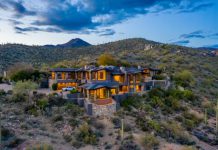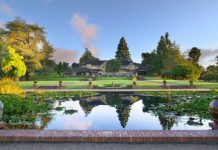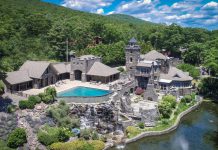From Dahlias and Debt to Fernleaf and Fortune
By Duncan Forgey
In the beginnings of modern day Newport Beach, the original port at McFadden’s Landing started near Bayshores. In 1889, the new ocean front wharf was completed. This being the anchor, workmen and residents built homes west and south along the peninsula beaches. The skeleton of a city was being born.
Isolated to the south of this activity, lay an area known simply as Rocky Point. It was nothing but a wind-blown bluff overlooking the “entrance” to Newport’s natural harbor. There was little water, no roads and no real reason to be there unless you were one of the cowboys tending to Irvine herds. The hamlets of Balboa and McFadden’s wharf could be seen from Rocky Point in the golden glow of a gorgeous Southern California sunset.
Due to a drought and the resulting hardship on ranch finances, James Irvine unloaded some of his least desirable lands to raise capital. In 1904, he sold 706 acres of land surrounding Rocky Point for $10,000 down and $150 an acre. “I consider it a good sale,” Irvine said, “almost one-fourth of the area is nothing but marshlands.” The benefactor of this purchase was George Hart.
Immediately, Hart started to improve the bluff top lands by creating lots, piping in water, grading Ocean Boulevard and building two piers. Additionally, a ferry service was available to access Rocky Point.
Original lots were 30’ by 118’ and ran along streets that were numbered like those over on the peninsula. They sold for $100 and the first recorded sale was on July 14, 1904 by C.S. Forgy, a Santa Ana real estate salesman. The sale was to Blanche Naylor at Ocean and Pier streets. The biggest addition was the Hotel Del Mar, located on the corner of 31st Street and 51st Place, which sat majestically on the hill and could be seen for miles.
By 1915, George E. Hart was financially defeated and traded for 5,000 acres of Riverside County land. The new owner the F.D. Cornell Company tried to market the area under the name “Balboa Palisades,” but it did not stick. Soon, the Spanish Corona del Mar or Crown of the Sea was to become the sobriquet for this latest addition to Newport Beach. Numbered streets gave way to flowers, so today’s buyers associate the CdM lifestyle with beautiful blooms such as narcissus, begonia, carnation, orchid and poinsettia.
Up to the Great Depression, CdM became a center for Hollywood studios to weave its magic. D.W. Griffith became a fan of the Corona del Mar bluffs and beaches. Macbeth, Cleopatra, The Son of Tarzan, The Count of Monte Cristo and Treasure Island starring Wallace Beery, a young Jackie Cooper and Lionel Barrymore were films with CdM as its background. Another famous visitor to Corona del Mar was waterman Duke Kahanamoku, who not only surfed the great waves of the harbor entrance, but also saved lives as a member of the “Life Saving Corps,” a precursor to modern day lifeguards.
By the time of the Great Depression, settlement in Corona del Mar had begun to take shape, but as a real estate investment, CdM was a financial disaster. Many of the parcels went back to the county in foreclosure for tax delinquencies. The hardy remained, but there was little work or a future.
Boyd Stillings and his wife walked the foreclosed lots and picked one on the corner of Dahlia and Seaview. They paid $375 for their lot, built a home and lived there until their deaths some 70 years later. Boyd could afford a lot on Ocean Boulevard, but explained that he saw no sense paying more money for such a windy location. Had he only known about CdM appreciation over the years, he might have put up with those pesky “onshores.”
During World War II growth was slow. In the 1950s, Newport Beach became the choice of the young and the daring to live and raise a family. Both the Corona del Mar residential and commercial districts grew together to become a cozy little beach community.
In the 1970s a new transition began. Young baby boomers saw a way to buy one of the area’s many duplexes, live in one unit and rent the other to help pay the mortgage. This would end years later when the property would be torn down and replaced with a new home or condos. These trend setters stabilized the area and transformed it from a largely rental area to a premier beach village. The dividing line in CdM was PCH, striving to be the next Rodeo Drive. Fashion Island squashed that dream, and the quaint and unique flavor of the Coast Highway lives on to this day.
Prices in CdM range from the expensive to the outrageously expensive. Condos on one of the flower streets are listed somewhere around $1,000,000 to as much as $2,000,000. Single-family residences are listed at a tad more: $1,000,000 to $17,000,000. The average sold price since January 2011 for condos is $974,638, while the average sold price for a single-family home in the same period is $1,859,094.
The real estate market in CdM is one of the best in all of Newport Beach. It rises faster than most and falls slower than most. It has been sluggish over the past years, but as always, it is one of the leading markets in Newport Beach.
When talking to locals, you may argue over whether it is called “Old” or “Olde” Corona del Mar. I guess it doesn’t really matter, because both give the area the gracious reverence that it deserves. “Corona del Martians” are happy and proud people that do care about their part of town, their appearance and their ZIP code. They sometimes tend to forget about the roots of CdM, which goes back to the blue collar west side of town.
They often don’t know that the first ferry in the harbor went to Rocky Point, that many people died using the harbor entrance before the jetties were built in the 1930s, that once upon a time you had to drive around the Back Bay to get there and most ironically, that developers had to go bankrupt before the Crown of the Sea could take its first real breath.
Now, Corona del Mar is home to youths chasing crabs at Big Corona, lovers holding hands and watching a sunset from Inspiration Point and multitudes of healthy CdM residents walking, running, biking and swimming in an attempt to keep the youthful lifestyle that they love so much.



